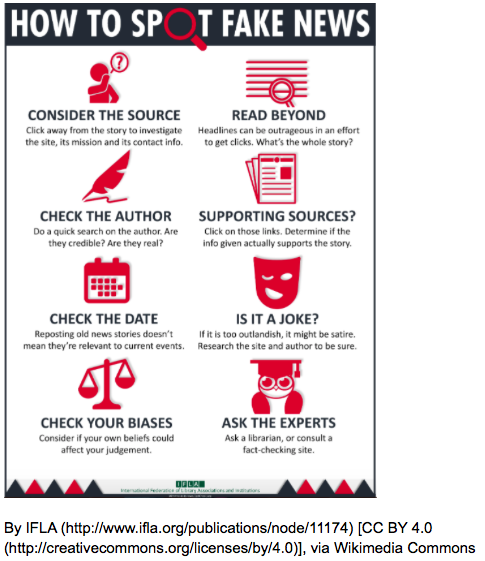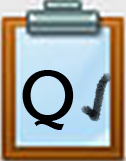Q5: Fake or Real News Step 3
Fact Check Political Stories
Every day there are political news stories that are published that are deceptive and misleading. There are three fact-checking sites to explore: FactCheck.org, Snopes, and PolitiFact. Compare these sites and select one to use to check whether or not the political article you just read is accurate. These sites monitor the factual accuracy of what is said by major U.S. political players in the form of TV ads, debates, speeches, interviews and news releases.
5. Your assignment is to visit to a popular news site such as CNN, ABC News, Huffington Post, or Fox News. Find a trending political news story. (you might want to find the same story on one or more news sites)
6. Next compare the information with one or more of these fact-checking sites: FactCheck.org, Snopes, or PolitiFact, and see if the story is listed on the site. If not, go back and look for another story to check on. If you can work with two partners you can quickly collect and compare your results together.
7. Use a word processing program to answer the following questions.
- What do the fact-check sites say about your story?
- How accurate is the reporting?
8. If you feel your story seems to be fake and you do not find anything on the fact-checking sites, look to see if you can Ask a Question. You can ask your question by filling out a short form. You will have to give an email address. If you don't have one, ask your parent/guardian or teacher if you can use theirs to have the fact-check site email the answer.
9. Share the story's headline and its URL with your teacher along with the facts about the story. If you sent a question, include the question and the answer once you have received it.
10. An additional resource to watch is a TedTalk "How We can Protect Truth in the Age of Misinformation". It is 15 minutes long and talks about how fake news can sway elections, tank economies and sow discord in everyday life.
- Your teacher may choose to watch this together as a class and discuss afterward.
Interactive Fun - How observant are you?
Test your observational skills with one or more of the following:
- Spot a Troll: You decide if each is an authentic account or a professional troll. After each profile you will review the signs that can help you determine if it's a troll or not. https://spotthetroll.org/start
- FakeOut: Your social media feed has been infected by false information. Your job is to learn the skills of verification, so you can sort fact from fiction.
https://newsliteracy.ca/fakeOut/
- Real or Photoshopped?
Photoshop users make the impossible possible, and for that, we thank them for taking creativity to places we never could have dreamed. Some things are so amazing, we're not sure if they're Real or Photoshop. Can you tell? https://landing.adobe.com/en/na/products/creative-cloud/69308-real-or-photoshop/index.html
Grades 10-12 Exploring Actual Examples of Newspaper Bias
This activity is from Common Sense Media.
The Teacher Guide and Directions for Students.
Before screening the video, ask students to take notes while they watch and to write down the five values.
- Show the Ethical Journalism Network video "The 5 Core Values of Journalism." or
- Optional: Hand out copies of the Society of Professional Journalists Code of Ethics.
View this resource Young Voters Guide to Social Media and the News from Common Sense Media. There are resources for parents and tools for teachers on the site too.
Competencies & Standards
MITECS Michigan Integrated Technology Competencies for Students, and
1. Empowered Learner
d. Understand the fundamental concepts of technology operations, demonstrate the ability to choose, use and troubleshoot current technologies, are able to transfer their knowledge to explore emerging technologies
2. Digital Citizen
a. Cultivate and manage their digital identity and reputation and are aware of the permanence of their actions in the digital world
b. Engage in positive, safe, legal and ethical behavior when using technology, including social interactions online or when using networked devices
d. Demonstrate an understanding of and respect for the rights and obligations of using and sharing intellectual property
3. Knowledge Constructor
a. Plan and employ effective research strategies to locate information and other resources for their intellectual or creative pursuits
b. Evaluate the accuracy, perspective, credibility and relevance of information, media, data or other resources
Websites and Documents
Websites
- ABC News
- Ask a Question Fact Check
- CNN
- Factcheck
- FakeOut
- Fox News
- Huffington Post
- Politifact
- Real Fake News: Exploring Actual Examples of Newspaper Bias
- Real or Photoshop
- Spot the Troll
- Snopes
- Young Voters Guide to Social Media and the News
Videos from Outside Sources
- Ethical Journalism Network "The 5 Core Values of Journalism" YouTube
- How False News Can Spread YouTube
- TedTalk "How we can Protect Truth in the Age of Misinformation" Video
21t4s Videos
21t4s Documents & Quizzes
21t4s Digital Breakout Challenge
What is a Digital Breakout?
A Digital Breakout may also be called a Digital Escape Room.
This is a web-based, game-like activity where students use clues to unlock a series of puzzles or activities to solve a challenge (or to escape a digital room).
Students frequently work together, (conference, or chat) as they work to locate and solve clues.
For additional help to solve a breakout view this short video (3:44).





